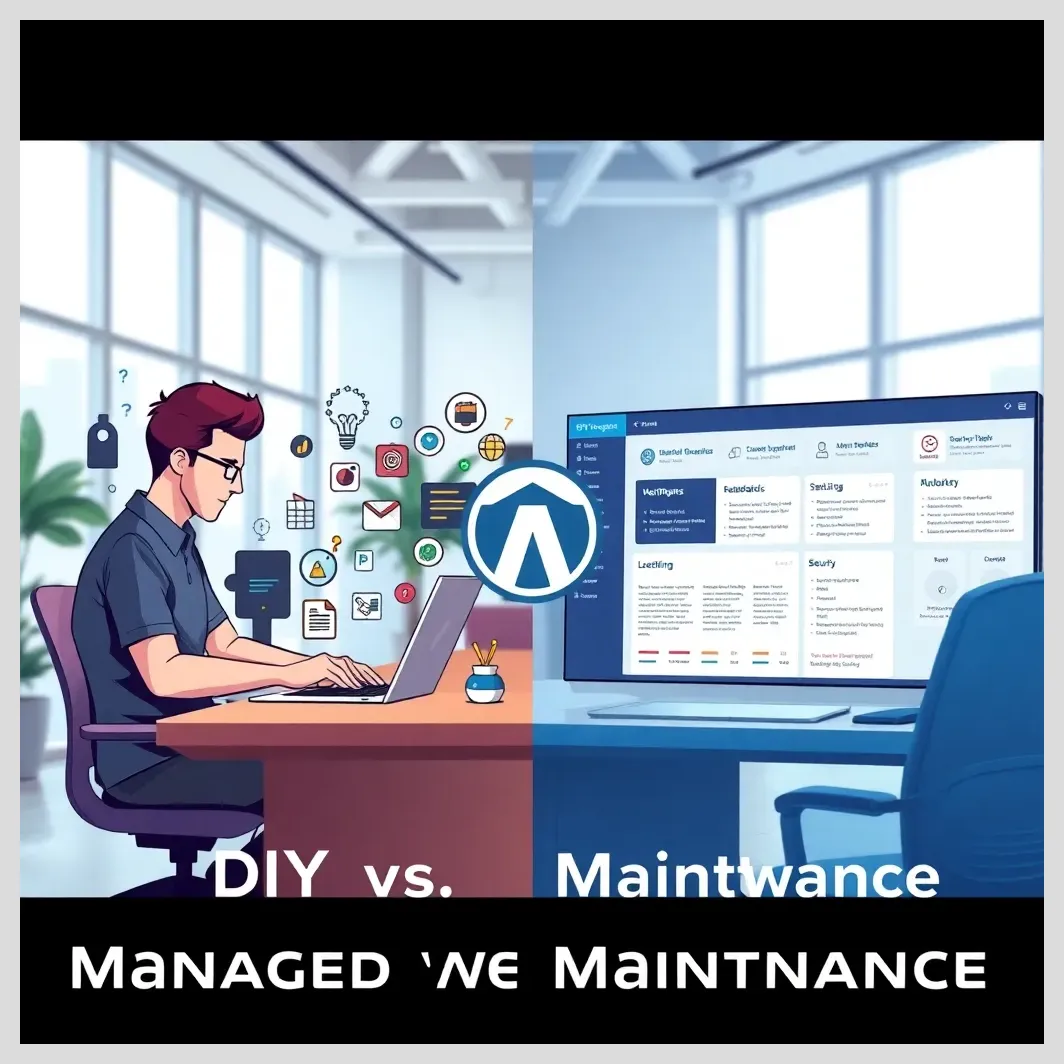In this article:
We dive deep into the world of website maintenance, specifically comparing DIY approaches with managed WordPress solutions. You’ll learn what each entails, who benefits most from each method, and how these choices impact your site’s security, performance, SEO, and overall reliability. We’ll also introduce you to Modular DS , a powerful tool that automates and centralizes WordPress maintenance for agencies and professionals.
Key points covered in this guide include
- Understanding the full scope of website maintenance beyond simple updates
- Profiles of users suited for DIY versus managed WordPress maintenance
- A detailed comparison table highlighting critical factors like security, backups, performance, and support
- How maintenance choices affect SEO and website uptime
- Cost considerations and long-term value of each approach
- Common pitfalls in DIY maintenance and when to consider switching to managed services
- Hybrid maintenance models combining the best of both worlds
- An in-depth look at Modular DS and how it compares to other WordPress maintenance services
- Practical tips, expert opinions, and real user testimonials
Website Maintenance
Maintaining a WordPress website is not just about keeping it alive; it’s about ensuring it runs smoothly, securely, and efficiently. For small business owners, bloggers, and entrepreneurs, a well-maintained site means better user experience, improved search engine rankings, and protection against cyber threats.
Website maintenance involves regular updates to WordPress core, themes, and plugins, performing backups, monitoring security, optimizing performance, and troubleshooting issues promptly. Neglecting these tasks can lead to slow load times, vulnerabilities, data loss, and ultimately, lost visitors or customers.
Choosing between DIY and managed WordPress maintenance is a common dilemma. DIY offers control and cost savings but requires technical skills and time. Managed services provide expert care, automation, and peace of mind at a higher cost. This guide will help you weigh these options carefully.
The Real Meaning of Website Maintenance: Beyond Just Updates
When we talk about website upkeep, it’s easy to think only of updating WordPress or plugins. But website maintenance is much broader. It includes
- Updates Keeping WordPress core, themes, and plugins current to patch vulnerabilities and add features.
- Backups Regularly saving copies of your site data to recover from crashes or hacks.
- Security Scanning for malware, applying patches, managing firewalls, and SSL certificates.
- Performance monitoring Ensuring fast load times and smooth user experience.
- Troubleshooting Diagnosing and fixing errors, conflicts, or downtime issues.
- Support Access to expert help when problems arise.
Proper maintenance builds a reliable, scalable website that can grow with your business. It reduces risks and keeps your site competitive in search rankings.
DIY vs Managed WordPress Maintenance: Practical Tips for Website Owners
Essential Maintenance Tasks
- Keep WordPress core, themes, and plugins updated regularly.
- Perform regular backups and test restore procedures.
- Monitor security with malware scans, firewalls, and SSL certificates.
- Optimize website performance and loading speed.
- Troubleshoot issues promptly to minimize downtime.
DIY Maintenance Tips
- Be prepared to invest time learning WordPress technical skills.
- Use trusted plugins for backups and security scans.
- Schedule regular manual updates and monitor site health.
- Avoid neglecting security best practices like strong passwords.
Managed Maintenance Benefits
- Automated updates, backups, and security scans save time.
- 24/7 expert support ensures quick issue resolution.
- Hosting optimized for WordPress performance and scalability.
- Predictable monthly costs reduce hidden expenses.
Common DIY Mistakes to Avoid
- Forgetting to update plugins and themes regularly.
- Neglecting backups or using unreliable backup methods.
- Overlooking security best practices like strong passwords and firewalls.
- Misconfiguring hosting or server settings causing slowdowns or errors.
When to Switch to Managed Maintenance
- Your website traffic or ecommerce complexity outgrows your technical skills.
- Frequent downtime or technical issues you cannot resolve quickly.
- Growing security concerns requiring expert handling.
- Desire to focus on business growth instead of technical upkeep.
Hybrid Maintenance Model Tips
- Manage content updates yourself to retain control.
- Outsource backups, security, and monitoring for convenience and safety.
- Use tools like Modular DS to centralize and automate maintenance tasks.
Who Should Consider DIY WordPress Maintenance?
DIY WordPress maintenance suits those comfortable with technology and willing to invest time learning and managing their site. Typical DIY users include developers, tech-savvy entrepreneurs, and hobbyists who want full control.
The benefits of DIY include
- Complete control over updates, backups, and customizations.
- Potential cost savings by avoiding monthly managed service fees.
- Learning opportunities that deepen your WordPress knowledge.
However, DIY also comes with challenges
- Time-consuming manual tasks like plugin updates and backups.
- Risk of errors causing downtime or security breaches.
- Need for technical skills to troubleshoot issues and optimize performance.
Common DIY tasks involve manually updating WordPress core, themes, and plugins, running security scans, configuring backups (often via plugins), and monitoring site health.
Who Benefits Most from Managed WordPress Maintenance?
Managed WordPress maintenance is ideal for bloggers, small businesses, ecommerce sites, and agencies that prefer to focus on content and growth rather than technical upkeep.
Advantages of managed services include
- Time-saving automation of updates, backups, and security scans.
- Professional expertise ensuring proactive monitoring and quick issue resolution.
- Optimized hosting environments tailored for WordPress performance.
- Reliable 24/7 support from WordPress specialists.
Managed services typically cover hosting optimization, uptime monitoring, daily backups, malware removal, and troubleshooting. While the monthly fees are higher than DIY hosting, the predictable costs and reduced risks often justify the investment.
Detailed Comparison: DIY vs Managed WordPress Maintenance
| Feature | DIY Maintenance | Managed WordPress Maintenance |
|---|---|---|
| Updates | Manual, user-driven | Automated, handled by experts |
| Security | User responsible for patches & scans | Proactive security, firewall, malware removal |
| Backups | Manual or plugin-based | Daily automated backups |
| Performance | Depends on hosting and user tuning | Optimized servers, CDN, caching |
| Support | Self-troubleshooting or forums | 24/7 expert support |
| Cost | Lower upfront, potential hidden costs | Higher monthly fee, predictable costs |
| Flexibility | High customization | Limited by managed platform |
| Scalability | Depends on user skills and hosting | Seamless scaling with professional help |

Diy vs managed wordpress maintenance
How DIY Maintenance Impacts Website Performance and SEO
Website performance and SEO rankings are tightly linked. Slow-loading pages frustrate visitors and increase bounce rates, which search engines notice. DIY maintenance can impact performance in several ways
- Outdated plugins or themes may cause slowdowns or conflicts.
- Neglected caching or CDN setup reduces speed.
- Security vulnerabilities can lead to blacklisting or penalties.
- Irregular backups risk data loss, affecting site availability.
Many DIY users underestimate the technical effort needed to keep performance optimized. Without regular monitoring and tuning, SEO health can suffer, limiting your site’s growth potential.
DIY vs Managed WordPress Maintenance: Feature Comparison
Key Insights
DIY maintenance offers greater control and lower upfront costs but requires technical skills, time investment, and carries risks of errors and security vulnerabilities. Managed WordPress maintenance automates critical tasks like updates, backups, and security with expert support, providing reliable performance and scalability at a higher predictable monthly cost. Choosing the right approach depends on your technical comfort, budget, and business growth goals.
 Monthly WordPress Website Maintenance Checklist
Monthly WordPress Website Maintenance ChecklistManaged WordPress Maintenance: How It Enhances Website Security and Uptime
Managed services take a proactive approach to security and uptime. They implement
- Advanced firewalls and malware scanning to block threats.
- SSL certificate management to secure data transmission.
- Continuous uptime monitoring with rapid incident response.
- Expert patch management to close vulnerabilities quickly.
Case studies show managed hosting clients experience fewer outages and faster recovery times. This reliability builds trust with visitors and search engines alike.

Diy vs managed wordpress maintenance
Exploring the Cost-Effectiveness of DIY vs Managed Maintenance
DIY maintenance may seem cheaper initially, but hidden costs add up
- Time spent on updates, troubleshooting, and backups.
- Potential revenue loss from downtime or security breaches.
- Costs for premium plugins or backup solutions.
Managed maintenance pricing varies but usually includes all essential services in a predictable monthly fee. The long-term ROI often outweighs the upfront savings of DIY, especially as your site grows.
Common Challenges and Mistakes in DIY WordPress Maintenance
DIY users often face pitfalls such as
- Forgetting to update plugins and themes regularly, leaving security holes.
- Neglecting backups or relying on unreliable methods.
- Overlooking security best practices like strong passwords and firewalls.
- Misconfiguring hosting or server settings, causing errors or slowdowns.
These mistakes can lead to downtime, data loss, or hacks that damage your reputation and SEO.
Benefits and Risks of DIY vs Managed WordPress Maintenance
Benefits
Full control over updates, backups, and customizations (DIY)
Cost savings by avoiding monthly managed service fees (DIY)
Learning opportunities to deepen WordPress knowledge (DIY)
Time-saving automation of updates, backups, and security scans (Managed)
Expert proactive monitoring and quick issue resolution (Managed)
Optimized hosting and 24/7 expert support (Managed)
Scalability with professional help for growing sites (Managed)
Risks
Time-consuming manual tasks like updates and backups (DIY)
Risk of errors causing downtime or security breaches (DIY)
Need for technical skills to troubleshoot and optimize (DIY)
Higher monthly fees and subscription costs (Managed)
Limited customization compared to DIY flexibility (Managed)
Dependence on provider for uptime and issue resolution (Managed)
When Is It Time to Switch From DIY to Managed WordPress Maintenance?
Signs you should consider managed services include
- Your site traffic or ecommerce complexity increases beyond your technical comfort.
- Frequent technical issues or downtime you can’t resolve quickly.
- Security concerns that require expert handling.
- Desire to focus on business growth rather than technical upkeep.
Managed services scale with your business, providing peace of mind and professional support.
Hybrid Approaches: Combining DIY and Managed Maintenance
Some users prefer a hybrid model, handling content updates themselves while outsourcing backups, security, and monitoring. This approach balances control and convenience.
Tools like Modular DS support hybrid workflows by centralizing maintenance tasks while allowing customization.
Hybrid maintenance suits users with moderate technical skills who want to save time without fully relinquishing control.
Introducing Modular DS: A Professional Solution for WordPress Maintenance Automation
Modular DS is a powerful platform designed for agencies and professionals to automate and centralize WordPress maintenance. Its core features include
- Automated updates for WordPress core, plugins, and themes.
- Centralized dashboard to manage multiple sites efficiently.
- Automated daily backups and security scans.
- Performance monitoring and uptime alerts.
- Scalable pricing plans to fit small to large portfolios.
Modular DS’s success stories show significant time savings and improved site reliability for users managing many WordPress sites.
Comparing Modular DS with Other WordPress Maintenance Services
| Criteria | Modular DS | Competitor A | Competitor B |
|---|---|---|---|
| Automation Level | High (centralized dashboard) | Medium (partial automation) | Low (mostly manual) |
| Integration | Supports multiple sites & plugins | Limited site management | Single-site focus |
| Pricing | Transparent, scalable | Variable, often higher | Low-cost but limited features |
| Support | Professional, responsive | Mixed reviews | Limited support |
| Customization | Flexible workflows | Fixed processes | Minimal customization |
Pros and Cons of Modular DS
- Pros Efficient, professional, scalable, user-friendly, cost-effective.
- Cons Higher upfront learning curve, subscription cost.
Real User Opinions and Testimonials on DIY vs Managed WordPress Maintenance
Across forums like Reddit and professional blogs, many users praise managed hosting for the peace of mind and expert support it provides. DIY users often share stories of steep learning curves and troubleshooting headaches but appreciate the control and savings.
Agency users of Modular DS highlight how it saves hours weekly by automating routine tasks and centralizing management. Case studies confirm improved uptime and fewer errors.
Practical Tips and Common Errors to Avoid in WordPress Maintenance
- Always keep WordPress core, plugins, and themes updated.
- Use reliable backup solutions and test restores regularly.
- Choose reputable plugins and avoid those with poor reviews or infrequent updates.
- Monitor your website’s health and performance consistently.
- Seek professional help when facing complex issues beyond your skills.
Expert Opinion: The Future of WordPress Maintenance and Hosting
The trend is clear: automation and managed services are becoming essential as websites grow more complex. Security and performance optimization will only increase in importance.
AI-powered monitoring tools and proactive maintenance solutions like Modular DS will play a bigger role, helping small businesses balance cost with reliability.
Summary: Making the Right Choice for Your Website Maintenance Needs
Choosing between DIY and managed WordPress maintenance depends on your technical skills, budget, and business goals. DIY offers control and cost savings but demands time and expertise. Managed services provide hassle-free, expert care with predictable costs and better scalability.
 24/7 WordPress Maintenance and Support Services UK
24/7 WordPress Maintenance and Support Services UKFor agencies and professionals managing multiple sites, Modular DS offers a compelling solution to automate and centralize maintenance, saving time and reducing risks.
Take Control of Your WordPress Website Maintenance Today
If you want to streamline your WordPress maintenance and focus on growing your business, consider trying Modular DS . Its automation and centralized dashboard make managing multiple sites easier and more reliable.
Explore their plans and see how they can save you time and headaches: Modular DS Pricing .
Have questions or want to learn more? Dive into our additional resources or reach out to the community for support.
References and Further Reading
- Liquid Web: Managed vs Unmanaged Hosting
- Giant Creates: Managed WordPress Hosting and Maintenance vs Regular Hosting
- Reddit: Managed WordPress vs Hosting Discussion
- Hashnode: DIY vs Managed WordPress Hosting
- NameHero: Do You Need a WordPress Maintenance Service?
- Medium: Self vs Managed WordPress Hosting
- Nexcess: When to Leave Shared Hosting & Upgrade to Managed WordPress
- CommonPlaces: Website Hosting DIY vs Self-Service
- Forbes: How to Decide Between Shared and Managed WordPress Hosting
- Modular DS Features
- Modular DS Case Studies
- Modular DS Pricing
Frequently Asked Questions About DIY vs Managed WordPress Maintenance
What is the difference between DIY and managed WordPress maintenance?
DIY maintenance means you handle all updates, backups, security, and troubleshooting yourself. Managed maintenance outsources these tasks to experts who automate and monitor your site for you.
How much does managed WordPress maintenance typically cost?
Costs vary but expect to pay a monthly fee ranging from $30 to $100+ depending on services and site complexity. Managed services bundle updates, backups, security, and support.
Can I switch from DIY to managed maintenance later?
Yes, many site owners start DIY and switch to managed services as their site grows or technical needs increase.
What are the risks of not maintaining my WordPress website?
Risks include security breaches, data loss, slow performance, downtime, and poor SEO rankings, all of which can hurt your business.
How does Modular DS simplify WordPress maintenance?
Modular DS automates updates, backups, security scans, and monitoring across multiple sites from a single dashboard, saving time and reducing errors.
What do you think about DIY vs managed WordPress maintenance? Have you faced challenges maintaining your site yourself or using managed services? How would you like your website maintenance to improve? Share your thoughts, questions, or experiences in the comments below!


















